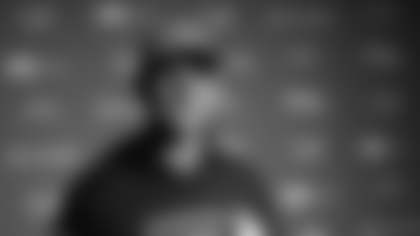BB: It's been impressive watching the Vikings so far this year. I think that obviously Coach [Mike] Zimmer has come in there with his program and it's been good – been good in preseason, it was certainly good in St. Louis last weekend. It looks like all three units – offense, defense, special teams – are strong, good contributors to the overall team. They have a lot of good players. It looks like they're well coached. They've made very few mistakes in the games that they've played and good on defense. They don't give up very many big plays, make some plays. Good in the kicking game; offensively don't turn the ball over – good running game, good passing game, explosive. It's a good football team. Home opener out there so this will be a big challenge for us this week. We'll need to have a good week of preparation. We'll need to play well on Sunday. They've done a good job. It's a good football team.
Q: Does your institutional knowledge of Matt Cassel help at all this week?
BB: It's [been] quite a while since he's been here, but he's a good player. We've seen him before.
Q: Just having seen him day-to-day for four years in the building, is that something that could help your defensive players?
BB: We know him; he knows us.
Q: You talked yesterday about how Norv Turner likes to motion and shift a lot. Defensively, how much of that is the offense trying to get the defense to show what it is doing? Is there a chess game there in terms of you want to react, but you don't want to show them how you're reacting?
**
BB:** There's probably a little bit of that. I think it's more of kind of what Norv has always done. He has his core, the core parts of his offense and just shifting and moving around makes it harder to recognize them. It looks like one thing and then they motion or shift and it's something else. You get your defense trained to recognize a certain look or certain alignment and then that gets taken away from you and you have to refocus on something else. So, a lot of times it's hard to recognize the play that they're running until right before, right when the ball is snapped. When you see the play, you look at it and say, 'There's that play,' but you don't have the opportunity to really hone in on it because it's kind of disguised with the motion and the shifting. That's, I think, kind of been a trademark of his offenses going all the way back to Dallas, San Diego, Oakland, Washington, Cleveland.
Q: Defensively is there a chain of command in terms of the communication on it? Does it start with Jerod Mayo or is it up to everybody to be able to communicate that?
BB: I think each individual player, all 11 of them, have certain things they're looking for depending what the call is and they're looking for keys in their area. Sometimes one guy might have a good key that he's able to relay to other people, but I'd say for the most part you're looking at the guys that you're keying on or that tight end, center, guard, backfield triangle, wide receiver to the tackle, whatever it happens to be, whatever position you're playing and you take your keys from that. As it changes, as it goes from a three-by-one to a two-by-two or two-backs set to a one-back or a one-back set to a two-back set or pro to slot or slot to pro or three-open to two-open or two-open to three-open then you have to transition those formations and who the people are in those spots as it occurs. They give you a lot of different looks. What we've seen this week and the week before is probably not what we're going to get anyway. They do a good job of that.
Q: Some of the defensive fronts you used last week, again, I can't speak to two-open, three-open, closed –
BB: Three-open is an offensive formation. It's not a defensive front.
Q: Last week, it seemed like you mostly used three down linemen in different situations. Do you want to transition week-to-week, sometimes three, sometimes four?
BB: We've played both before. We'll do what we think is best for that individual game, that matchup, that offensive system. It might change, might not.
Q: That open thing is where the tight end is, right?
BB: It could be. When you look at the offensive formation, they've either got one extended player, two, three, sometimes four, sometimes all five if it's an empty set. Depending on how many people are close to the formation and how many people are detached, that kind of affects the fundamental of your defense. In Minnesota's case, there are a lot of 12 personnel – two tight ends, two receivers and one back. Sometimes the two receivers are detached and there are nine guys in the formation, sometimes a tight end is detached so there are only eight guys in the formation. Sometimes they are detached and there are only seven guys in the formation. But those kinds of things, to recognize those defensively, makes a big difference. Sometimes they start out wide and motion a guy back in, sometimes they start in close and motion a guy back out. That's what I was referring to.
Q: That's going to impact all the alignments.
BB: Well, it depends on what you're in; it depends on what call you have. Certainly, if there's a blocker in the C gap area where the tight end would normally line up, that's one element of a running game. If the guy's not there, that eliminates a lot of things they can do. They can't double team block on a defensive tackle, they can't reach the outside guy on the end of the line. It just changes what they can do in certain sets. If the two tight ends are together, that gives them a lot of opportunity to create a lot of blocking angles on one side that if they're not there together, a lot of those blocking angles don't exist anymore. It doesn't mean you can't do things, it's just they're different.
Q: Can you talk about Cordarrelle Patterson and Adrian Peterson and what you see in the challenge in facing them?
BB: Adrian is a really explosive player; excellent vision, very strong, good speed. He can run up inside, he can off-tackle, he can run outside. He can go the distance, he breaks a lot of tackles and he has good run vision. He's really an excellent player. Patterson is obviously an explosive guy. You see that in the return game. He's a deep threat. He's dangerous with the ball in his hands, whether you hand it to him or throw it to him on a short pass. He's a dangerous catch-and-run guy, he's also a vertical guy. In the Kansas City game, he caught the flag pattern. He's a strong player, kind of like Peterson – big, strong, hard to tackle, good speed, at a different position.
Q: How comfortable are you using the tablet on the sideline?
BB: When it works, [I'm] comfortable with it. When it doesn't work, you have to find something else. It's no different than what we talked about after the first or second preseason game, it's the same issue now as it was then. It's probably going to be the same issue all year. The wireless system on the field, if it's connected then you can see what's on there. If it's not connected, then you can't see what's on there. That's really the issue. I'd say every game that we've used them in there have been times where it works fine. There are other times where you lose the connection and you don't have it. I'm sure that's probably true of most other teams, too, at least other coaches that I've talked to made the same type of comments. That's what it is.
Q: Does it get frustrating if you have an ill-timed loss of connection?
BB: Well, it's no different than the picture setup. Maybe not at this point, I'd say it's probably less dependable than the pictures. But that was an issue with the pictures. Sometimes you had the pictures, sometimes – I've been in games where we've lost them, too. Either the printer goes down or something, some technology things.
Q: Is it a cross your fingers situation?
BB: I'd say it's a little better than that, but it's no different than the coach to quarterback communication system. Most of the time it's fine, but then at times it will go out and you have to have another way to communicate, whether that's signals or just turning it over to the person on the field or bringing the technician over and getting it fixed. I'd say that's all kind of part of the game. It happens and it happens pretty frequently. I'm not saying every other play, but I'm saying frequently. I can't think of too many games where we haven't had something somewhere along [the way]. Occasionally, it's the coach to the – the sideline to the press box. I'd say that's less frequent. When that happens then there's a rule in place where you notify the official and then the other sideline has to shut down their communication as well. So everybody can kind of see when that happens. It happens, but I'd say that's less frequent. The other situation, the coach to quarterback, the tablets, the pictures, things like that, that's self-contained and if it breaks down then you deal with it during the game and you fix it and the other team does what they do.
Q: Was Patterson someone you looked at in the pre-draft process?
BB: We look at every player. We start off with somewhere around 2,000 to 3,000 players and whittle it down. Obviously there's not 2,000 prospects, but the seniors at all the Division I teams, the seniors at Division II and III that are pro prospects for some reason or another – size, speed, production, however that unfolds. That's where the process starts. It all whittles down to guys ending up on the draft board. Yeah, we evaluate – every player, we evaluate the players in the other professional leagues and we evaluate some players that don't even play football, the Steve Neals of the world, if you will. Yeah, of course we evaluate him.
Q: When you have a situation where you always want to be moving forward, is there also a balance system where you want to say, 'We need to play with more urgency than last week.' While you're concentrating on Minnesota, not making the same mistakes you made in Miami.
BB: That's pretty much what the day after the game is for, however the game turns out, whatever the final score is. That's pretty much what the day after the game is for, to correct the mistakes, to talk about the things that went well in the game that you want to build on and reinforce and the things that didn't go well in the game that you need to correct or improve or adjust, other situations that you just flat out learned from that maybe isn't good or bad, it's just experience that you want to convey to your team. That's kind of what Mondays are for and when we come in on Wednesday, we're on to the next team. We're on to Minnesota. We're done with Miami. Whatever we had to talk about or do with Miami, we're past that. We're on to Minnesota. I'd say that's pretty much the way it is every week. That's what the day after the game is for.








































